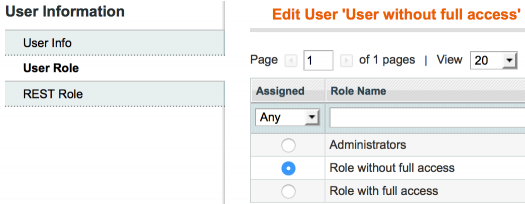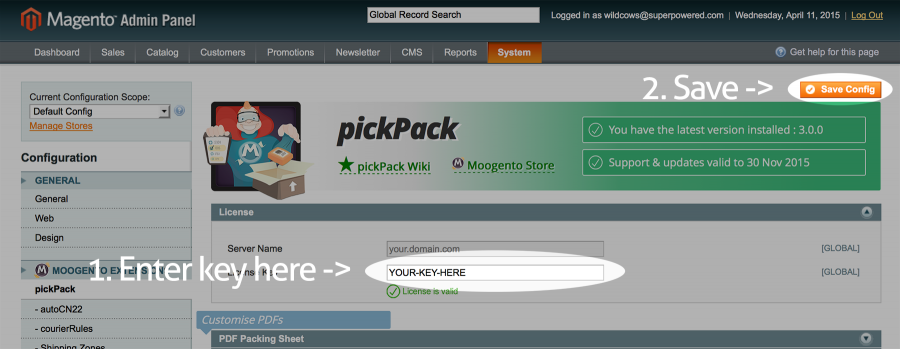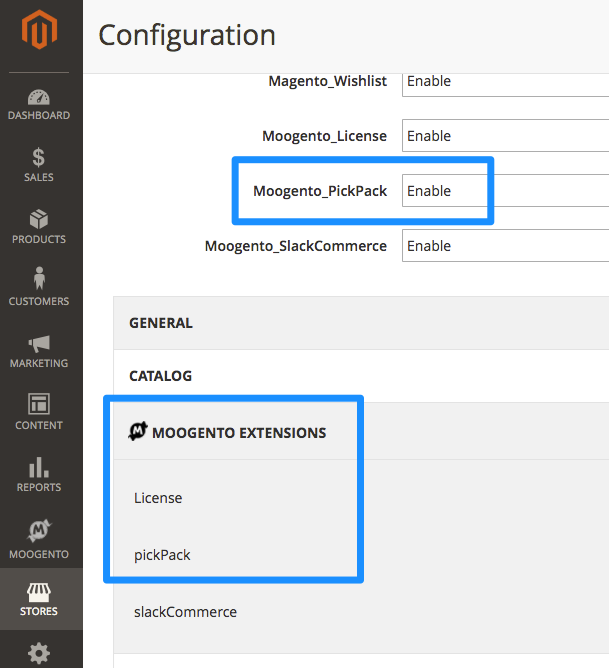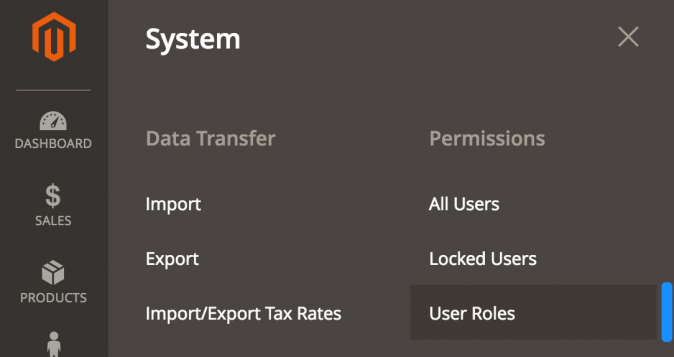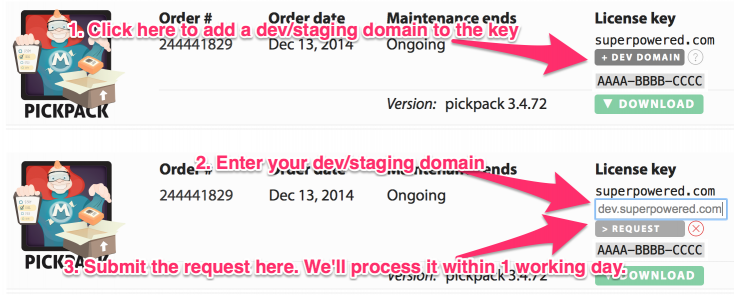Difference between revisions of "Installing Magento Extensions : Easy Install Guide"
m |
m |
||
| Line 61: | Line 61: | ||
# Inside that you'll see {{folder|app}} and {{folder|m2.0.patches}}. Open this containing folder inside your FTP app. | # Inside that you'll see {{folder|app}} and {{folder|m2.0.patches}}. Open this containing folder inside your FTP app. | ||
# Locate your website's Magento {{folder|app}} folder in the same FTP app. You should now have the unzipped {{folder|app}} on one side, and your main website folder (containing the Magento app folder) on the other side. | # Locate your website's Magento {{folder|app}} folder in the same FTP app. You should now have the unzipped {{folder|app}} on one side, and your main website folder (containing the Magento app folder) on the other side. | ||
| − | #: * ''Check that you see an {{folder|app}} folder each side.''[[File: | + | #: * ''Check that you see an {{folder|app}} folder each side.''[[File:magento-2-plugin-installation.png|link=|674px]] |
| − | # Drag the {{folder|app}} folder from inside the unzipped folder into your remote site (the important thing here is not to drag on top of another folder, or the files will be placed in the wrong location - easiest is to drag onto a file or blank space on the remote side).[[File: | + | # Drag the {{folder|app}} folder from inside the unzipped folder into your remote site (the important thing here is not to drag on top of another folder, or the files will be placed in the wrong location - easiest is to drag onto a file or blank space on the remote side).[[File:drag-n-drop-copy-app-folder.png|link=|674px]] |
# You may be asked {{keypress|Merge or Replace?}} by your FTP app. Choose {{keypress|Merge}} for folders and {{keypress|Replace}} for files.[[File:merge_folders_replace_files.png|link=|800px]] | # You may be asked {{keypress|Merge or Replace?}} by your FTP app. Choose {{keypress|Merge}} for folders and {{keypress|Replace}} for files.[[File:merge_folders_replace_files.png|link=|800px]] | ||
# ''Only if you're using a version of Magento 2 that's less than 2.1'', copy {{folder|m2.0.patches}} into your remote root folder, overwriting any file changes. | # ''Only if you're using a version of Magento 2 that's less than 2.1'', copy {{folder|m2.0.patches}} into your remote root folder, overwriting any file changes. | ||
| Line 80: | Line 80: | ||
===4. Check Installation=== | ===4. Check Installation=== | ||
Head to {{menu3|Stores|Configuration|Advanced -> Advanced}} and you should see your new module in the admin panel. | Head to {{menu3|Stores|Configuration|Advanced -> Advanced}} and you should see your new module in the admin panel. | ||
| + | #:[[File:moogento-installed-magento-2.png|link=|674px]] | ||
===5. Clear Cache and Set User Permissions=== | ===5. Clear Cache and Set User Permissions=== | ||
| Line 85: | Line 86: | ||
#:'''Do this even if you have caching generally disabled.''' | #:'''Do this even if you have caching generally disabled.''' | ||
# Log out then Log in. | # Log out then Log in. | ||
| − | # Head to {{menu3|System|Permissions|Roles}} | + | # Head to {{menu3|System|Permissions|User Roles}} |
| + | #:[[File:magento-2-user-roles.png|link=|674px]] | ||
# Check that you have assigned the new Moogento Extension options to the appropriate roles, and save. | # Check that you have assigned the new Moogento Extension options to the appropriate roles, and save. | ||
#:*If saving an admin role, likely you have 'All' resources set; just re-save this: | #:*If saving an admin role, likely you have 'All' resources set; just re-save this: | ||
| − | #:[[File:magento- | + | #:[[File:magento-2-user-all-role-access.png|link=|674px]] |
| − | #:*If saving a partial access role (eg. granting pickers access to create Packing Sheets), find the new extension sections and grant as needed (eg. here is access to | + | #:*If saving a partial access role (eg. granting pickers access to create Packing Sheets), find the new extension sections and grant as needed (eg. here is access to edit the PDF templates): |
| − | #:[[File: | + | #:[[File:magento-config-settings-pickpack.png|link=|674px]] |
| − | |||
| − | |||
# Head to {{menu3|System|Permissions|Users}} | # Head to {{menu3|System|Permissions|Users}} | ||
# Check that you have assigned the correct role (that we just granted the appropriate Extension options to) to the appropriate users, and save. | # Check that you have assigned the correct role (that we just granted the appropriate Extension options to) to the appropriate users, and save. | ||
| − | |||
===6. Enter The License Key=== | ===6. Enter The License Key=== | ||
Revision as of 16:29, 24 February 2017
Aims & Preparation
Make sure you've gone through the Pre-install Checklist before starting!
Upgrading from an older version? Check our Upgrading Extensions Guide
---- Magento 1 ----
1. Upload The Files
- Unzip your extension package.
- Inside that package you'll see Step_1, open that folder inside your FTP app.
- Locate your website's Magento app folder in the same app. You should now have the contents of Step_1 on one side, and your main website folder (containing the Magento app folder) on the other side. Check that you see an app folder each side.

- Drag the folders from inside Step_1 into your remote site (the important thing here is not to drag on top of another folder, or the files will be placed in the wrong location - easiest is to drag onto a file or blank space on the remote side).

- You may be asked Merge or Replace? by your FTP app. Choose Merge for folders and Replace for files.

- When that has completed, open Step_2 in your unzipped extension folder.
- Using the same procedure, copy the contents of Step_2 into the same location in your Magento installation.

- If you're using a 3rd party admin theme, you may need to also copy the contents of skin/adminhtml/default/default folder into both skin/adminhtml/default/[skin name] and skin/adminhtml/go
- If you're installing pickPack and are going to be attaching fonts to your PDFs (eg. custom fonts or non-Roman characters), then, also using the same procedure, copy the contents of Step_Optional_Font_Pack into the same location in your Magento installation.
2. Clear the Cache and Assign User Permissions
- Go to the SystemCache settings, and clear all caches (click Flush Magento Cache and Flush Cache Storage).
- Do this even if you have caching generally disabled.
- Log out then Log in.
- This will allow you to edit the config page for this extension (and avoid the 404 error).
- Head to SystemPermissionsRoles
- Check that you have assigned the new Moogento Extension options to the appropriate roles, and save.
- If saving an admin role, likely you have 'All' resources set; just re-save this:
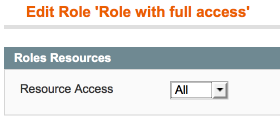
- If saving a partial access role (eg. granting pickers access to create Packing Sheets), find the new extension sections and grant as needed (eg. here is access to mass-action menu options):
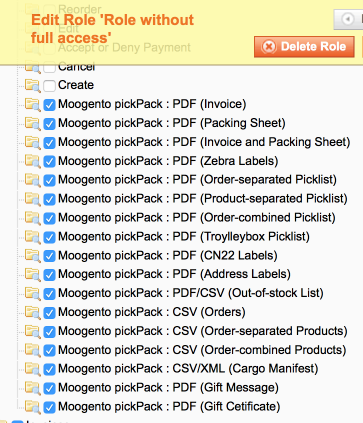
- Don't forget to set the access to the System>Configuration section if you need to:
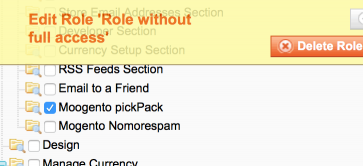
- Head to SystemPermissionsUsers
- Check that you have assigned the correct role (that we just granted the appropriate Extension options to) to the appropriate users, and save.
3. Enter the License Key
If you're installing a Moogento extension, we'll have sent you a license key. Let's install it!
- Navigate to SystemConfiguration and then to the specific config page for your new Extension.
- At the top, if this extension requires a license key, enter your license key (this will have been emailed to you; you can also find it inside your Moogento account downloads section).
- Click the 'License' word to expand that section if it's not already showing the key entry field.
- Enter the key and save the page:
4. Save the Config Page
After entering the license key, save the config page.
- Even if you're installing an extension without a license key, it's still a good idea to save the config section at this point (even if you've not made any changes).
- (It's possible to generate some errors if running some extensions without values saved to the config).
- Clear the Magento cache, and then the browser cache.
If you're not sure about browser cache, what usually works is holding the shift button and clicking refresh.
---- Magento 2 ----
1. Upload The Files
- Unzip your downloaded zip and open the single folder (usually the extension name).
- Inside that you'll see app and m2.0.patches. Open this containing folder inside your FTP app.
- Locate your website's Magento app folder in the same FTP app. You should now have the unzipped app on one side, and your main website folder (containing the Magento app folder) on the other side.
- * Check that you see an app folder each side.

- * Check that you see an app folder each side.
- Drag the app folder from inside the unzipped folder into your remote site (the important thing here is not to drag on top of another folder, or the files will be placed in the wrong location - easiest is to drag onto a file or blank space on the remote side).

- You may be asked Merge or Replace? by your FTP app. Choose Merge for folders and Replace for files.

- Only if you're using a version of Magento 2 that's less than 2.1, copy m2.0.patches into your remote root folder, overwriting any file changes.
- If you're installing pickPack and are going to be attaching fonts to your PDFs (eg. custom fonts or non-Roman characters), then, also using the same procedure, copy the contents of Step_Optional_Font_Pack into the same location in your Magento installation.
- * Get the extra font zipped folder from inside your account Downloads folder.
2. Disable the Cache
Disable the cache in SystemCache Management
3. Run Setup Scripts
- Run this on the command line (when logged-in to the remote server):
php f bin/magento setup:upgrade
- then we're going to upgrade the database, with any new tables needed by the plugin:
php f bin/magento setup:dbschema:upgrade
4. Check Installation
Head to StoresConfigurationAdvanced -> Advanced and you should see your new module in the admin panel.
5. Clear Cache and Set User Permissions
- Go to the SystemCache settings, and clear all caches (click Flush Magento Cache and Flush Cache Storage).
- Do this even if you have caching generally disabled.
- Log out then Log in.
- Head to SystemPermissionsUser Roles
- Check that you have assigned the new Moogento Extension options to the appropriate roles, and save.
- If saving an admin role, likely you have 'All' resources set; just re-save this:
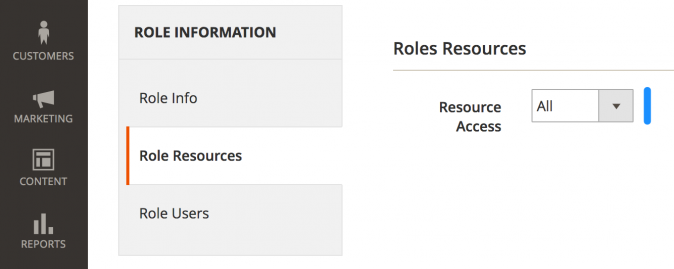
- If saving a partial access role (eg. granting pickers access to create Packing Sheets), find the new extension sections and grant as needed (eg. here is access to edit the PDF templates):
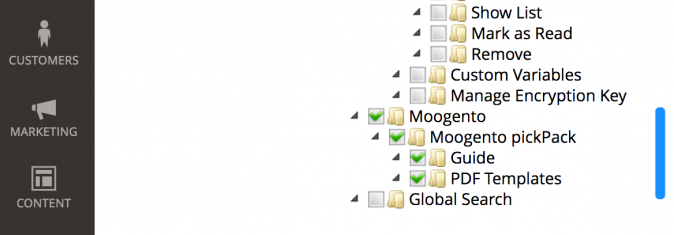
- Head to SystemPermissionsUsers
- Check that you have assigned the correct role (that we just granted the appropriate Extension options to) to the appropriate users, and save.
6. Enter The License Key
If you're installing a Moogento extension, we'll have sent you a license key. Let's install it!
- Navigate to SystemConfiguration and then to the specific config page for your new Extension.
- At the top, if this extension requires a license key, enter your license key (this will have been emailed to you; you can also find it inside your Moogento account downloads section).
- Click the 'License' word to expand that section if it's not already showing the key entry field.
- Enter the key and save the page:
7. Save The Config Page
After entering the license key, clear the cache and logout again.
- Even if you're installing an extension without a license key, it's still a good idea to save the config section at this point (even if you've not made any changes).
---- Magento 1 & 2 ----
Registering Your License For Dev/Staging Sites
If you're setting up on a dev or staging server, we've got you covered. You can assign up to 2 dev/staging servers to each key, and we have a super-simple way to assign them.
- Navigate to your Moogento Account downloads section.
- Find the specific extension you want to request dev/staging access for.
- Click '+ dev domain'
- Enter the domain name.
- Click 'Request'
- Done! We'll check that and assign it within 1 working day.
- If your dev site is not an obvious dev subdomain (dev. / stage. / etc.) please ensure that the site is showing the Magento 'demo site' message.
- Enter the license key in every install you make with our software, including dev & staging sites.
- Before installing the software, please add the domain you'll be using to the list of authorised domains, as described above.
- It's against the terms of your license to use the software:
- - without entering the license key in every install
- - without authorising the domain before use
- (only needed if you're using multiple domains for testing - the first-used domain is registered automatically)
- - without authorising the domain before use
- - on multiple Magento installations
- (excepted : dev/staging sites for the specific domain the key is purchased for)
- - on multiple Magento installations
Quick Check Extension Is Installed Ok
- Check that it works at a basic level; this is also a good time to check your public store front. I would also make a test order at this stage, check that the emails you're expecting are coming through etc.
- If everything is ok and you have previously disabled compilation, now you can enable it.
You should now be setup at a basic level.
If you have any issues, check the Troubleshooting guide.
